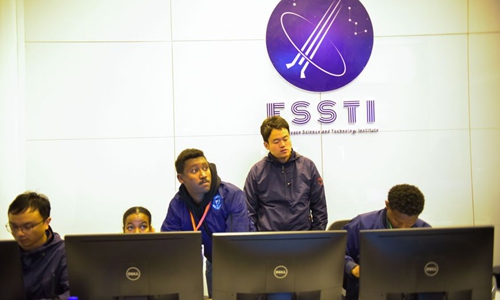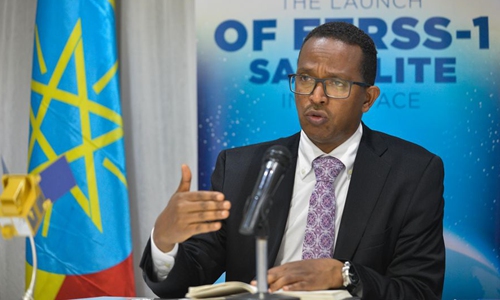Social media flooded by posts on Chinese-backed Ethiopian maiden satellite launch
Source:Xinhua Published: 2019/12/23 15:59:48

Chinese and Ethiopian engineers go about their work during a satellite launch at Entoto Observatory Center in Addis Ababa, capital of Ethiopia, Dec. 20, 2019. Photo:Xinhua
Many Ethiopian social media users have been posting, with pictures and captions, about Ethiopia's maiden satellite dubbed ETRSS-1, following the successful launch on Friday of the East African country's first ever satellite into space from China.
Ethiopians both at home and abroad have been expressing their joy with posts on their own Facebook walls, while others writing congratulatory messages, positively commenting on and sharing friends' posts about the launch of the satellite, from a space center in China.
The satellite is expected to monitor the environment and weather patterns for better agricultural planning, drought early warning, mining activities and forestry management of the country.
China has forged partnership in developing Ethiopia's space science sector, whereby it has closely worked with Ethiopia's Ministry of Innovation and Technology (MoIT) to train Ethiopian space engineers as well as help the launch of ETRSS-1.
Ethiopian engineers will monitor the satellite from the multi-satellite tracking and data receiving ground station built at Entoto Observatory on the hill of Entoto in the outskirt of Ethiopia's capital Addis Ababa.
A huge gathering including senior government officials, diplomats, space engineers, as well as other dignitaries and residents of Addis Ababa on Friday attended the event organized at Entoto Space Observatory Facility to follow the launch of the satellite from China.

Ethiopia's Minister of Innovation and Technology Getahun Mekuria speaks during a press briefing in Addis Ababa, capital of Ethiopia, Dec. 15, 2019. Photo:Xinhua
Speaking during the event televised live from Entoto Space Observatory Facility, Ethiopia's Deputy Prime Minister, Demeke Mekonnen, hailed the launch of ETRSS-1 as a "historic stride."
A large Ethiopian delegation composed of senior Ethiopian government officials and media personalities have also attended the launch of Ethiopia's first space satellite in China.
Speaking to Xinhua, Beza Tesfaye, General Manager of Ethiopia Space Science Society (ESSS), expressed satisfaction over the successful launch of Ethiopia's first ever satellite to space through the support of China.
Beza further said China, which currently is one of only nine countries in the world self-sufficient in orbital launch capability, has been generous in availing its space science technology know-how and facilities to Ethiopia.
The Ethiopia Minister of Innovation and Technology, Getahun Mekuria, has told Xinhua on his part that ETRSS-1 would help Ethiopia save much-needed foreign currency that it currently spends to get information from foreign-owned satellites.
In his televised address on Friday, the Ethiopian Prime Minister Abiy Ahmed said the launch of ETRSS-1 into space has marked the start of a historic moment in Ethiopia's quest towards the development of space science sector.
"Congratulations to all Ethiopian nationals as we launched our country's first-ever satellite today," Ahmed said, adding that "I believe that this satellite, which was registered as the first-ever satellite to be launched to orbit in our country's history, will not be the last as it will be followed by many others in the future."
Stating that the Chinese-backed satellite would play a crucial role in modernizing Ethiopia's agriculture, Ahmed hailed the role of the project in transferring knowledge from the Chinese to Ethiopians in satellite projects.
Ethiopian Facebook users have lauded the successful launch of the satellite with their posts in local and foreign languages, most of their posts carried congratulatory messages, saying "Congratulations to all Ethiopians!"
Ethiopia's 72 kg multi-spectral remote sensing satellite, ETRSS-1, is stationed in 700 km away from the earth.
Posted in: AFRICA,AIR & SPACE